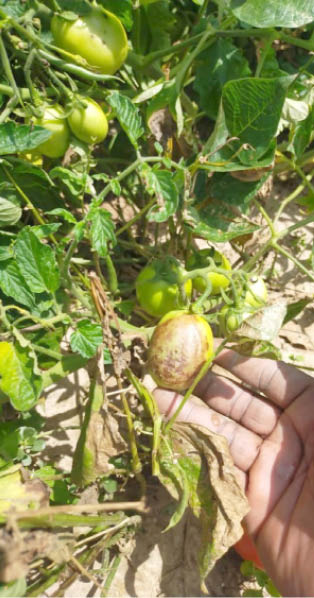AGRO SOLUTIONS – An infected tomato farm
Based on your report on tomato disease in Jos, how can farmers identify it at an early stage? Aminu Shekwo, Idah, Kaduna State According to Mallam Abubaka Sanni, a retired agriculturist, the best thing to do if you suspect your tomato farm of any disease is to look for yellowing leaves to indicate the start […]

Tomato disease
Based on your report on tomato disease in Jos, how can farmers identify it at an early stage?
Aminu Shekwo, Idah, Kaduna State
According to Mallam Abubaka Sanni, a retired agriculturist, the best thing to do if you suspect your tomato farm of any disease is to look for yellowing leaves to indicate the start of an infection. Fungal infections usually affect the leaves first. Yellow or green discolorations on the leaves often indicate the start of a disease. These spots may spread in blotchy spots or affect the whole leaf. A particular pattern can determine which fungus the plant has.
Tomato plants can develop a number of diseases throughout their lifecycle, ranging from bacterial and viral infections to mold and fungal growths.
Disease symptoms usually start on the plant leaves, so check here for any discolorations or lesions.
Wikihow.com listed the following steps you can take to identify a disease in your tomato farm.
Look for yellowing leaves to indicate the start of an infection
Yellow blotches or specks are usually a type of leaf mold. These spots may be paired with browning areas on the bottom of the leaf. If the entire leaf turns yellow, then the disease is probably fusarium wilt, also caused by a fungus.
Remember that discolored leaves can also indicate a bacterial or viral infection. If the discolorations come with no other symptoms, then your plant may have a nutrient or water deficiency.
Recognise round, brown lesions as a sign of blight
Blight is a common fungal infection on tomatoes and other plants. Its telltale sign is an outbreak of brown lesions on the plant leaves. The size and appearance of those lesions distinguish what type of blight the plant has.
Both early and late blight present dark, brown, circular lesions on the leaves. The lesions may develop a yellow border before engulfing the whole leaf.
Early blight lesions are smaller and present a bulls-eye shape with a defined border. Late blight lesions grow larger and don’t always develop a perfectly round border.
Late blight lesions develop a rough, leathery texture. Buckeye rot lesions look similar to late blight ones, except that they stay smooth, whereas late blight lesions are rough.
Brown blotches on the stem are a sign of southern blight
This particular type of blight starts at the soil level and usually affects the stem first. Check the lower parts of the stem for brown blotches. This is usually the first sign of a southern blight.
Other forms of blight also present brown blotches on the stem, but usually, the infection doesn’t start there. Instead, they start on the leaves.
Find smaller brown specs to indicate Septoria leaf spot
This fungal infection also presents brown leaf lesions, but they look different from blight lesions. They are small specs that look like spilled coffee grounds. A yellow border surrounds the lesions. In time, the whole leaf will turn yellow and fall off.
Look for brown blotches on the fruit to confirm blight
Blight also affects the tomatoes themselves. It usually causes large brown blotches on the crop. Most fruits will fall off before reaching maturity.
Source: wikihow.com
